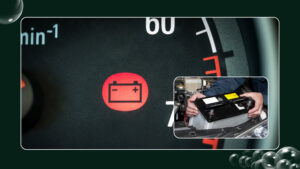
Car Battery Light On Fault While Driving? (7 Common Causes)
All new vehicles on the road today are equipped with 12 volt rechargeable batteries. The battery powers almost all of the vehicle’s electrical components, such as the ignition system, engine control unit, headlights, radio, interior lights, and more.
If the battery does not hold a charge or is completely discharged, your vehicle will not work. In the past, there were only two ways that car owners could know when their cars would expire. They should test the battery voltage or wait for the lights to come on.
Today, in modern vehicles, there is a battery light in the dashboard that comes on whenever the computer detects a problem with the battery charge. General Motors vehicles (including Chevrolet, Cadillac and GMC) will drive off and display the “Activate Power Save Mode” message.
This is useful because it gives you a chance to fix the problem before the battery uses up the energy it contains. This will keep you from getting stuck somewhere while driving. What does the battery light mean?
There are many reasons why the battery light may come on while driving your vehicle. Here are 7 real reasons to help you diagnose your problem. Sometimes you will find more than one issue, but this list will give you a general idea of what to look for in a vehicle.
Once you find the cause, you can fix the problem. This means repairing some parts or replacing all or part of them.
#1 – Corrosion Battery Terminal
This is a common problem that usually occurs when the starter motor turns off, making it difficult to start the vehicle. However, sometimes the corrosion on the battery post or terminal can be damaged by the flow of electricity, causing the inverter to malfunction. This will keep the battery light on after you start the vehicle.
If you see a white gritty or powdery substance where the battery cables meet the terminals, this indicates corrosion. The way to solve it is easy. Disconnect the battery cable and use a mixture of baking soda and water (1 tablespoon added to 200ml water) to clean the posts and terminals with a toothbrush.
You can also use an electrical terminal cleaning brush or wire brush to remove the rust.
#2 – Loose Car Battery Cables
Just like corroded battery terminals and an incomplete connection to the charge, if the battery cables are not properly connected the battery light will come on while driving. Usually, this happens right after a bump in the road or after installing a new battery.
To secure them, make sure the battery cables are far enough away from the battery post, then simply use a screwdriver or socket (10mm for most vehicles) and tighten the nuts on each port until the switch stops. If you still find rust, remove it before tightening.
#3 — Weak Battery
If your battery is more than 3 years old, don’t assume that the battery itself is undamaged or completely dead. This is especially true if you drive every day or live in a hot geographic area like Florida.
Car batteries drain faster if they are used in high temperatures. If your car battery is low, your car lights will stay on. Although car batteries are sold with different warranty periods (ie: 48 months, 72 months or 96 months), don’t expect them to last that long…it’s hard. Depending on how your battery is damaged during the warranty period, you may be entitled to a free replacement or credit towards the purchase of a new battery.
To determine if the battery is damaged, use a multimeter to test the voltage. Connect the negative cable to the negative terminal of the battery and the positive (red) cable to the positive terminal of the battery.
You should get a voltage reading of 12.4 and 12.7 volts. If the reading is below 12.2 volts, your battery may need to be replaced.
#4 – Alternator Failure
The life expectancy of an alternator on a vehicle is 5 to 7 years (approximately 80,000 to 120,000 miles). As you know, the alternator is responsible for maintaining the battery while you drive your car. However, regardless of the reason the converter is damaged, the battery cannot be saved.
#5 — A faulty alternator belt
The transmission belt connects the crankshaft and the alternator together. If your transmission belt is damaged, loose, or damaged, your alternator will not work properly.
As a result, your car battery will not be able to provide the power it needs to power your vehicle’s electrical components. So, your car battery light will come on because of this. Replacing the transmission belt is the only solution.
#6 – Bad Ground Strap
The vehicle ground cable connects to the negative terminal of the car battery. If a bad battery cable is damaged or worn, it can affect the flow of electricity to the vehicle’s electrical components.
Also, a bad ground cable can block the battery light while you’re driving. If you find that the ground wire is damaged, you should replace it.
#7 — Too Many Accessories (Air Con)
If your battery voltage is correct and the alternator is charged correctly, the number of devices you turn on while driving will keep the battery light on. However, if the charging system is not working properly, the number of electrical components used while driving can accelerate the battery drain.
Your car needs plenty of electricity for heating, air conditioning, power steering, and headlights. When you start adding other accessories like windshield wipers, power, rear defroster, fuel pump, GPS system, DVD player, or charging your cell phone, the costs start to increase. electrical requirements.
If you see a low battery light while driving, try turning off the AC and other non-essential components to see if that helps. At the very least, you will keep the energy in the battery so that you can achieve your goals and solve your problems.

